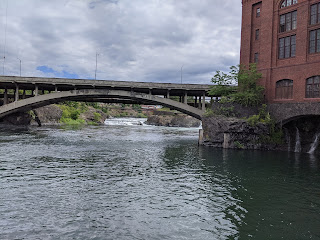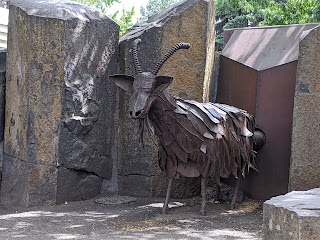Steven and I hadn't originally planned on seeing anything in Spokane but it was much cheaper staying there than in nearby Coeur D'Alene, Idaho, where we had hoped to see friends a couple of times who had relocated from Denver. But, because of the coronavirus, we had extra time on our hands so headed to downtown Spokane. The city had started out as an active trading post, the first non-Native one in the Pacific Northwest. The Northwest Fur Company operation was established in 1810 shortly after the Lewis & Clark Expedition. But it wasn't 1872 that the nucleus of the city began by Spokane Falls.
What kid at heart wouldn't love this huge Radio Flyer wagon at the city's Riverfront Park?! The Childhood Express sculpture was created in honor of Washington State's Centennial in 1989 as a gift for the children of Spokane.
The wormy, snake-like, aluminum Centennial Sculpture floated in the Spokane River.
The city's landmark Clock Tower in Riverfront Park has stood near the Spokane River since 1902, built originally as part of the Great Northern Railroad Depot on Havermale Island. I read online that a 700-pound, solid brass pendulum keeps the clock mechanism on time and chiming every hour. It was neat to learn the clock, which had never had bells, was programmed to play a different song every hour and can be set to play holiday jingles, college fight songs or other melodies!
The centerpiece of the city park was the 1909 Looff Carousel that began operating in 1909 in an amusement park on the bank of the Spokane River on the west side of Spokane. The carousel was relocated in 1967 to Riverfront Park and loved by children until 2016. It then went into storage until this new building was built.
If it weren't for Covid-19, we would have been able to gaze in wonder in person at what had been described as one of the country's most preserved and well deserved wooden carousels. No wonder, then, that the carousel had been placed on the National Register for Historic Places. We had to be content, though, just peering through the windows and looking at the animals.
Nearby was the Rotary Riverfront Fountain that was dedicated to the people of Spokane in 2005. No water was flowing, though, in the huge sprinkler. I couldn't help but wonder if that was also because of Covid-19 to discourage people from frequenting the otherwise fun spot.
We walked a few blocks toward Huntington Park and the Spokane Falls. Overhead was a gondola connecting people between the two parks and a view of the falls with City Hall in the background.
The park, owned by Avista (formerly the Washington Water Power Company), was named after David Huntington, the company's third president in the 1920s. The park was developed in the early 1970s and redeveloped in 2013 to promote public use and enjoyment. Huntington Park was the site of Avista's Monroe Street Hydroelectric Development which has generated electricity since 1890.
Huntington Park offered spectacular, close-up views of Spokane's lower falls. There was a great waterfront walkway down to the park's lower level.
Another view of the gondolas passing under the bridge:
For thousands of years, tribal families from miles around gathered at the falls to fish for salmon. During fish runs, the eddy below the falls became a seething mass of struggling salmon. Sometimes there were so many fish, the rocks below the falls weren't visible.
In 1974, when Spokane hosted the World's Fair, it was the smallest city to do so by far and was just a tenth the size of New York's World' Fair a decade earlier. This had been the US pavilion.
Walking across the Wiley Pedestrian Bridge allowed us to have some marvelous views of Inspiration Point, Canada Island, and the city.
I had fun taking a few shots of the US pavilion roof when we walked back through Riverfront Park.
The city's Vietnam Veterans' Memorial was rather small compared to the vastly more impressive one we'd just seen in Portland.
The Washington State Pavilion housed the state's exhibits at the World's Fair and its 2,700-seat performing arts auditorium allowed for a wide range of international entertainment for fair attendees.
Created for Expo 74 was this abstract bronze sculpture of a moon crater, aptly called Moon Crater!
This steel sculpture imaginatively called Garbage Goat would apparently eat small pieces of trash with the aid of its vacuum digestive system but we never saw it working!
Spokane's five Sister Cities were Jilin, China; Jecheon, South Korea; Cagli, Italy; Limerick, Ireland; and Nishinomiya, Japan.
Next post: That afternoon we drove just thirty minutes to Coeur D'Alene over in western Idaho for a hike on Tubbs Hill before meeting up with our former Denver friends. Our further exploration of Spokane would have to wait for a couple of days!
Posted on October 23rd, 2020, from Denver on our first morning home after returning from our long road trip to the Midwest and Southeast. I hope you stay safe, well, and connected during these trying times. I'll add also stay warm this time because it's darn chilly here and we're due for snow!







































Welcome Home. Lil Red
ReplyDeleteThanks, Janina. Nice to be home after driving just 30 miles short of 9,000 miles through a good chunk of the Midwest and South.
ReplyDelete